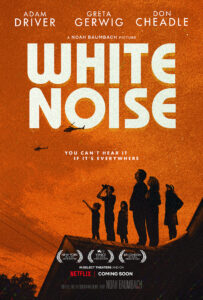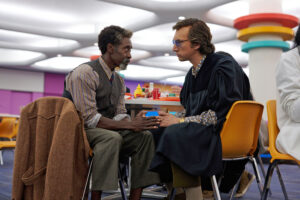 By Steve Crum
By Steve Crum
The plot is both the least to worry about as well as the least to understand in White Noise. After sitting through its 136 minutes, I am mesmerized. To call White Noise unconventional is to put it, well, mildly. It is a fragmented mess of a plot, yes. It is wildly a spectacle, yes.
See it.
 One need only check Noah Baumbach’s film credentials to nod yes to describing White Noise. He is pretty much the auteur behind it. Baumbach directs, produces, and writes the screenplay. He has cast past collaborators Greta Gerwig and Adam Driver as the leads. Even though Wes Anderson is not part of the production team this time, White Noise has Anderson overtones.
One need only check Noah Baumbach’s film credentials to nod yes to describing White Noise. He is pretty much the auteur behind it. Baumbach directs, produces, and writes the screenplay. He has cast past collaborators Greta Gerwig and Adam Driver as the leads. Even though Wes Anderson is not part of the production team this time, White Noise has Anderson overtones.
Baumbach has been compared to Woody Allen in individualizing his movies, and so goes this film. Yet it maintains the distinctive Baumbach stamp. Consider his stylistic works The Squid and the Whale and Marriage Story.
 A plot description paints a quirky picture of the way off kilter central family that evolves into a dark comedy full of whacky characters behaving under multiple life or death circumstances.
A plot description paints a quirky picture of the way off kilter central family that evolves into a dark comedy full of whacky characters behaving under multiple life or death circumstances.
Where to begin? Why not start in 1984 with Jack Gladney (Adam Driver), a professor of “Hitler Studies” at a small college in Ohio. By the way, Jack does not speak German—a growing concern since he is scheduled to give a speech at an upcoming conference where he is expected to sprechen Deutsch. It makes Baumbach sense that Jack’s best friend is his colleague, Prof. Murray Siskind (Don Cheadle), who is encouraged by Jack to develop a course in “Elvis Studies.”
Back on the home front, Jack is married to his fourth wife, Babette (Greta Gerwig). They are raising a very blended family of four children.  Older daughter Denise (Raffey Cassidy) catches her mother using a secret prescription of Dylar, a “mysterious drug,” as the story segues into nightmarish dreams of death experienced by Jack.
Older daughter Denise (Raffey Cassidy) catches her mother using a secret prescription of Dylar, a “mysterious drug,” as the story segues into nightmarish dreams of death experienced by Jack.
Death is literally in the air when a nearby train derailment casts a cloud of toxic fumes over the quaint college town, and the entire city is forced to evacuate. Cut to long traffic lines inching along, including the car of Jack, Babette and family. There is also a potential tragedy in the works here. (There is also a memorable sequence wherein the Gladney car is converted to a water raft.)
During the third movie’s wild third act, things have moved on to paranoia, death anxieties, and murder threats at a motel.
 But never fear? Without divulging too much, be advised to pay attention to the entire credit roll, which includes some checkout lanes at a vintage store…and a singable-danceable tune by Danny Elfman. Strangely, this finale sequence really sold me on White Noise.
But never fear? Without divulging too much, be advised to pay attention to the entire credit roll, which includes some checkout lanes at a vintage store…and a singable-danceable tune by Danny Elfman. Strangely, this finale sequence really sold me on White Noise.
∞∞∞∞∞
GRADE on an A-F Scale: B
